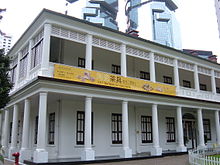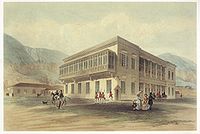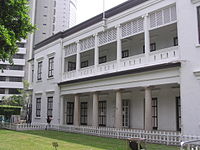- Flagstaff House
-
Flagstaff House Chinese 旗杆屋 Transcriptions Mandarin - Hanyu Pinyin Qí Gān Wū - Wade–Giles Ch'i2 Kan1 Wu1 Cantonese (Yue) - Jyutping kei4 gon1 uk1 - IPA [kʰḙi kɔ́ːn ʔʊ́k] Museum of Tea Ware Chinese 茶具文物館 Transcriptions Mandarin - Hanyu Pinyin Chá Jù Wén Wù Guǎn - Wade–Giles Ch'a2 Chü4 Wen2 Wu4 Kuan3 Cantonese (Yue) - Jyutping caa4 geoi6 man4 mat6 gwun2 - IPA [tsʰa̭ː kɵ̀y mɐ̭n mɐ̀t kʷǔːn] Designated: 14 Sep 1989 Reference #: 36 Flagstaff House is the oldest example of British-style architecture remaining in Hong Kong. It is located in 10 Cotton Tree Drive, Central - within the Hong Kong Park.
It has been a longtime residence of the Commander of the British forces in Hong Kong during colonial times. Today Flagstaff House houses the Museum of Tea Ware. The building is a popular setting for wedding photography.
Contents
History
Flagstaff House had been named as Headquarter House until 1932. There is some disagreement as to who designed it, but it was completed in 1846 and initially served as the military headquarters office and residence of the Commander of the British forces in Hong Kong.[1] The site chosen was a small bluff above the barracks and above Queen's Road, then at the waterfront.
The building was designed in Greek revival style. Historians suspect it was designed either by Murdoch Bruce, a Scottish who was inspector of buildings, or by Lieutenant Bernard, collinson of the Sappers.[1] The first occupant was Major-General George Charles D'Aguilar, General Officer Commanding from 1844 to 1846 who also held the post of Lieutenant Governor.[1]
The west and east wings were shelled during the Japanese invasion, and it suffered bomb damage. The Japanese repaired it and the Commandant took the building as his residence during the occupation.[1]
After the war, Flagstaff House was again the Commander's residence until 1978, when the Commander moved to a purpose built house on Barker Road. It was handed over by the military to the civilian Hong Kong Government as part of the surrender of Victoria Barracks. The Government put it under the responsibility of the Urban Council in 1981.[1]
The building was declared a monument in 1989. It was restored as far as possible to its original mid-19th-century appearance, structurally reinforced, and the interior was to be modified so that it could be used as a museum.[1]
Museum of Tea Ware
In 1984, the Flagstaff House was converted into the Flagstaff House Museum of Tea Ware, a branch museum of the Hong Kong Museum of Art. The museum specializes in the collection, study and display of teaware, including many samples of the Yixing teapot, from Jiangsu Province of China, as well as the world's oldest known extant teapot.
A new wing, the K.S. Lo Gallery, was added in 1995. It is named after a local collector, which made a donation to the city in the 1970s. This donation now constitutes the core of the museum's collection. The new gallery contains a collection of ceramics and Chinese seals.
See also
- Hong Kong tea culture
- Museums in Hong Kong
- List of buildings and structures in Hong Kong
- History of Hong Kong
References
- ^ a b c d e f Eric Cavaliero, Proud house on a hill, The Standard, 16 January 1997
External links
Coordinates: 22°16′42.60″N 114°9′45.0″E / 22.2785°N 114.1625°E
Art museums and galleries in Hong Kong Flagstaff House • Fringe Club • Hong Kong Museum of Art • Museum of Contemporary Art, Asia • Tsui Museum of Art • University Museum and Art Gallery • Visual Arts CentreCategories:- Declared monuments of Hong Kong
- Landmarks in Hong Kong
- Hong Kong Park
- Central, Hong Kong
- Art museums and galleries in Hong Kong
- Official residences in Hong Kong
- Decorative arts museums
Wikimedia Foundation. 2010.




